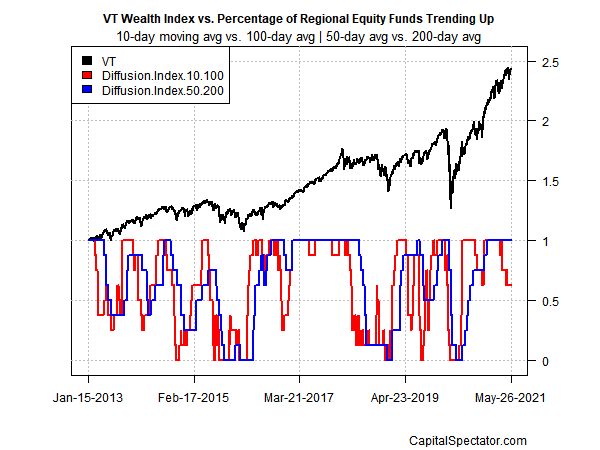Shares in Europe have taken the lead for 2021 returns among the world’s main equity regions (based upon returns for a set of exchange-listed funds through May 26.)
Over the past month, Vanguard FTSE Europe Index Fund ETF Shares (NYSE:VGK) has displaced US stocks as the year-to-date performance leader. At yesterday’s close, VGK was up 14.3% so far in 2021, edging out the 12.5% gain for SPDR® S&P 500 (NYSE:SPY).

Several factors appear to explain the recent strength in European stocks, including comments from European Central Bank President Christine Lagarde, who said last week that it was premature to begin talking about ending its bond-purchasing program that helps keep interest rates unusually low.
Analysts have also been advising that European stocks offer lower valuations vs. US shares, which suggests that expected returns are higher for the former.
The Financial Times today reports that:
“Investors are increasingly optimistic, encouraged as the eurozone emerges from a double-dip recession caused by the pandemic and member states roll out coronavirus vaccines after a delayed start blamed on supply shortages and patchy public health campaigns.”
Agnès Belaisch, a strategist at fund manager Barings, says:
“this is Europe’s chance to actually take off,” adding that the opportunity “is not completely priced in to stock markets.”
All the main equity regions are currently posting gains for 2021, although there’s a wide spread between the leaders and laggards. The weakest performer: iShares Latin America 40 ETF (NYSE:ILF), which is ahead this year by just 1.0%.
World stocks overall (including US companies) are posting a strong return, based on Vanguard Total World Stock Index Fund ETF Shares (NYSE:VT), which is currently posting an 11% year-to-date increase.
Only Europe (VGK) and US (SPY) have outperformed in 2021 through Thursday’s close.
Looking at the funds listed above through a momentum lens reminds that a bullish bias recently dominated in the extreme—a bias that may have peaked for the near term. The analysis is based on two sets of moving averages.
The first measure compares the 10-day average with its 100-day counterpart—a proxy for short-term trending behavior (red line in chart below). A second set of moving averages (50 and 200 days) represent an intermediate measure of the trend (blue line).
Using data through yesterday’s close suggests that the uniformly upside bias is fading on the short-term front, which may be an early sign that a new phase of weaker perform for equities is brewing for the trading cycle.

